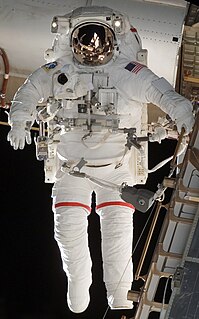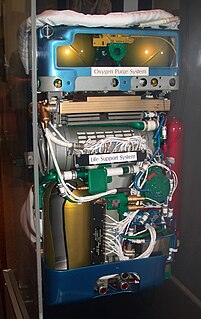
A space suit or spacesuit is a garment worn to keep a human alive in the harsh environment of outer space, vacuum and temperature extremes. Space suits are often worn inside spacecraft as a safety precaution in case of loss of cabin pressure, and are necessary for extravehicular activity (EVA), work done outside spacecraft. Space suits have been worn for such work in Earth orbit, on the surface of the Moon, and en route back to Earth from the Moon. Modern space suits augment the basic pressure garment with a complex system of equipment and environmental systems designed to keep the wearer comfortable, and to minimize the effort required to bend the limbs, resisting a soft pressure garment's natural tendency to stiffen against the vacuum. A self-contained oxygen supply and environmental control system is frequently employed to allow complete freedom of movement, independent of the spacecraft.

A mechanical counterpressure (MCP) suit, partial pressure suit, direct compression suit, or space activity suit (SAS) is an experimental spacesuit which applies stable pressure against the skin by means of skintight elastic garments. The SAS is not inflated like a conventional spacesuit: it uses mechanical pressure, rather than air pressure, to compress the human body in low-pressure environments. Development was begun by NASA and the Air Force in the late 1950s and then again in the late 1960s, but neither design was used. Research is under way at the Massachusetts Institute of Technology (MIT) on a "Bio-Suit" System which is based on the original SAS concept.

The Extravehicular Mobility Unit (EMU) is an independent anthropomorphic spacesuit that provides environmental protection, mobility, life support, and communications for astronauts performing extravehicular activity (EVA) in Earth orbit. Introduced in 1981, it is a two-piece semi-rigid suit, and is currently one of two types of EVA spacesuits used by crew members on the International Space Station (ISS), the other being the Russian Orlan space suit. It was used by NASA's Space Shuttle astronauts prior to the end of the Shuttle program in 2011.

The Quest Joint Airlock, previously known as the Joint Airlock Module, is the primary airlock for the International Space Station. Quest was designed to host spacewalks with both Extravehicular Mobility Unit (EMU) spacesuits and Orlan space suits. The airlock was launched on STS-104 on July 14, 2001.

Personnel Armor System for Ground Troops is a combat helmet and ballistic vest that was used by the United States military from the early 1980s until the mid-2000s, when the helmet and vest were succeeded by the Lightweight Helmet (LWH), Modular Integrated Communications Helmet (MICH), and Interceptor Body Armor (IBA) respectively.

An atmospheric diving suit (ADS) is a small one-person articulated submersible which resembles a suit of armour, with elaborate pressure joints to allow articulation while maintaining an internal pressure of one atmosphere. An ADS can enable diving at depths of up to 2,300 feet (700 m) for many hours by eliminating the majority of significant physiological dangers associated with deep diving. The occupant of an ADS does not need to decompress, and there is no need for special gas mixtures, so there is little danger of decompression sickness or nitrogen narcosis when the ADS is functioning properly. An ADS can permit less skilled swimmers to complete deep dives, albeit at the expense of dexterity.

ILC Dover, LP is a special engineering development and manufacturing company, globally headquartered in Newark, Delaware. ILC Dover specializes in the use of high-performance flexible materials, serving the aerospace, personal protection, and pharmaceutical industries.

The Apollo/Skylab space suit is a class of space suits used in Apollo and Skylab missions. The names for both the Apollo and Skylab space suits were Extravehicular Mobility Unit (EMU). The Apollo EMUs consisted of a Pressure Suit Assembly (PSA) aka "suit" and a Portable Life Support System (PLSS) that was more commonly called the "backpack". The A7L was the PSA model used on the Apollo 7 through 14 missions.

The Advanced Crew Escape Suit (ACES), or "pumpkin suit", is a full pressure suit that Space Shuttle crews began wearing after STS-65, for the ascent and entry portions of flight. The suit is a direct descendant of the U.S. Air Force high-altitude pressure suits worn by the two-man crews of the SR-71 Blackbird, pilots of the U-2 and X-15, and Gemini pilot-astronauts, and the Launch Entry Suits (LES) worn by NASA astronauts starting on the STS-26 flight, the first flight after the Challenger disaster. The suit is manufactured by the David Clark Company of Worcester, Massachusetts. Cosmetically the suit is very similar to the LES. ACES was first used in 1994.

Sidemount is a scuba diving equipment configuration which has scuba sets mounted alongside the diver, below the shoulders and along the hips, instead of on the back of the diver. It originated as a configuration for advanced cave diving, as it facilitates penetration of tight sections of cave, allows easy access to cylinder valves, provides easy and reliable gas redundancy, and tanks can be easily removed when necessary. These benefits for operating in confined spaces were also recognized by divers who conducted technical wreck diving penetrations.

The I-Suit is a spacesuit model constructed by ILC Dover. The suit began as an EVA mobility demonstrator, developed to meet a contract awarded by NASA to ILC in 1997 for an all-soft suit.

A primarylife support system (PLSS), is a device connected to an astronaut or cosmonaut's spacesuit, which allows extra-vehicular activity with maximum freedom, independent of a spacecraft's life support system. A PLSS is generally worn like a backpack. The functions performed by the PLSS include:

The Mark III or MK III (H-1) is a NASA space suit technology demonstrator built by ILC Dover. While heavier than other suits, the Mark III is more mobile, and is designed for a relatively high operating pressure.

The Krechet-94 is a space suit model developed for lunar excursion during the Soviet manned lunar program. It was designed by NPP Zvezda. Development began in 1967, concurrently with the Orlan suit for microgravity spacewalks. The developmental model was known simply as Krechet.

The Constellation Space Suit was a planned full pressure suit system that would have served as an intra-vehicular activity (IVA) and extra-vehicular activity (EVA) garment for the proposed Project Constellation flights, which were planned to begin after the Space Shuttle retired. The design of the suit was announced by NASA on June 11, 2008, and it was to be manufactured by Houston, Texas-based Oceaneering International, the first company other than the David Clark Company, Hamilton Sundstrand, and ILC Dover to produce life-support hardware, as a prime contractor, for in-flight space use.

A powered exoskeleton, also known as power armor, powered armor, powered suit, cybernetic suit, cybernetic armor, exosuit, hardsuit, exoframe or augmented mobility, is a mobile machine that is wearable over all or part of the human body, providing ergonomic structural support and powered by a system of electric motors, pneumatics, levers, hydraulics or a combination of cybernetic technologies, while allowing for sufficient limb movement with increased strength and endurance. The exoskeleton is designed to provide better mechanical load tolerance, and its control system aims to sense and synchronize with the user's intended motion and relay the signal to motors which manage the gears. The exoskeleton also protects the user's shoulder, waist, back and thigh against overload, and stabilizes movements when lifting and holding heavy items.

The Z series is a series of prototype extra-vehicular activity (EVA) space suits being developed in the Advanced Extravehicular Mobility Unit (AEMU) project under NASA's Advanced Exploration Systems (AES) program. The suits are being designed to be used for both micro-gravity and planetary EVAs.

The goaltender or goalie is a playing position in indoor or box lacrosse. More heavily armoured than a field lacrosse goaltender, since the invent of indoor lacrosse in 1931, the box lacrosse goalie has evolved into a much different position than its field lacrosse cousin.

Human factors in diving equipment design are the influence of the interaction between the diver and the equipment on the design of the equipment. The underwater diver relies on various items of diving and support equipment to stay alive and in reasonable comfort and to perform the planned tasks during a dive. The design of the equipment can strongly influence its effectiveness in performing the desired functions.




















